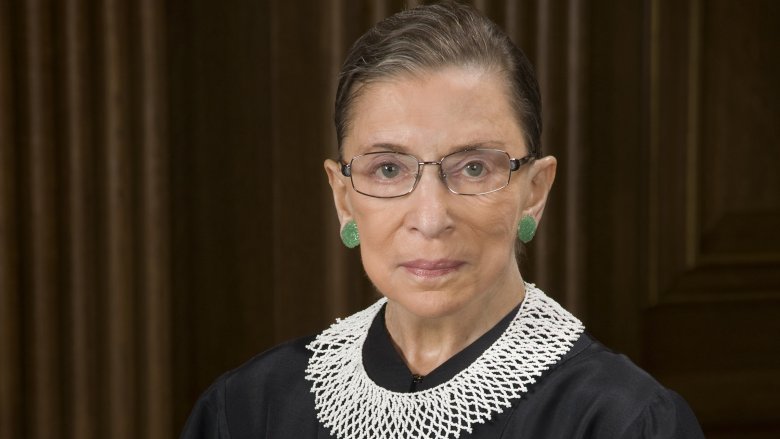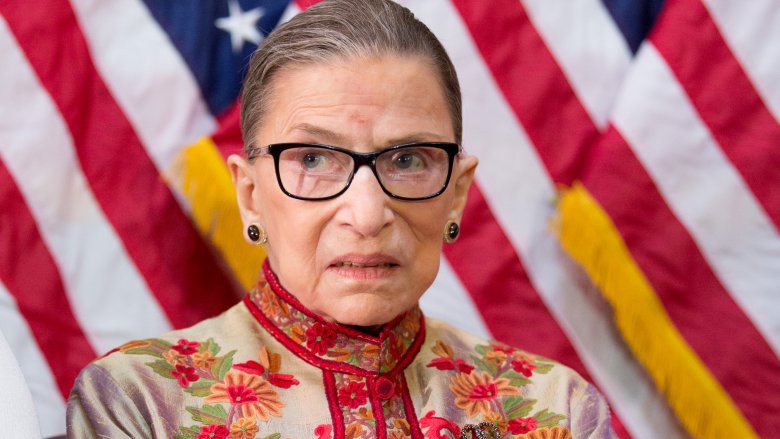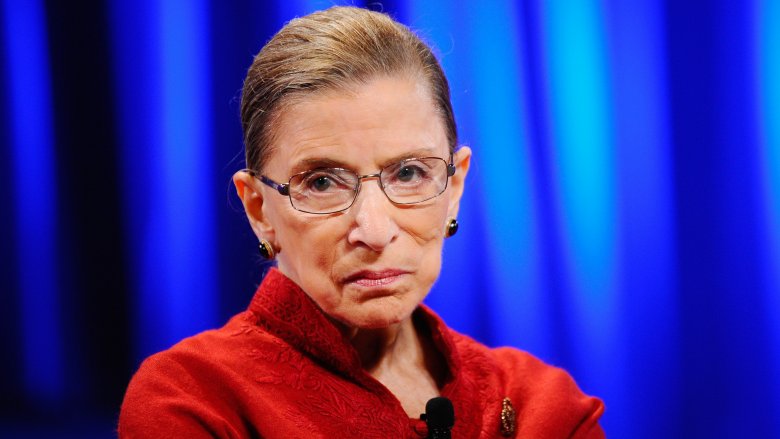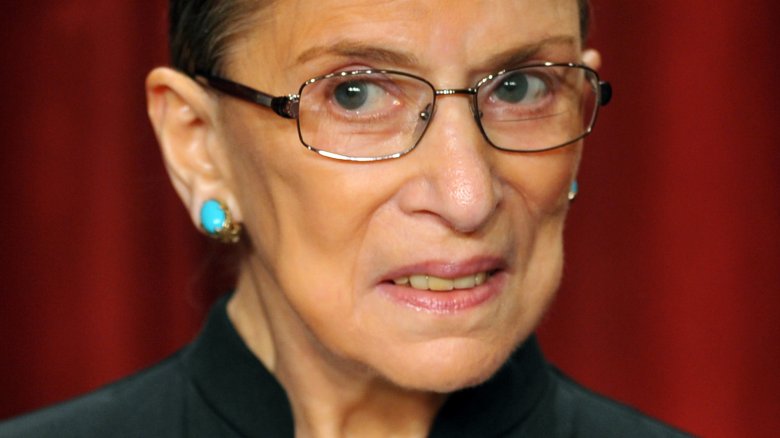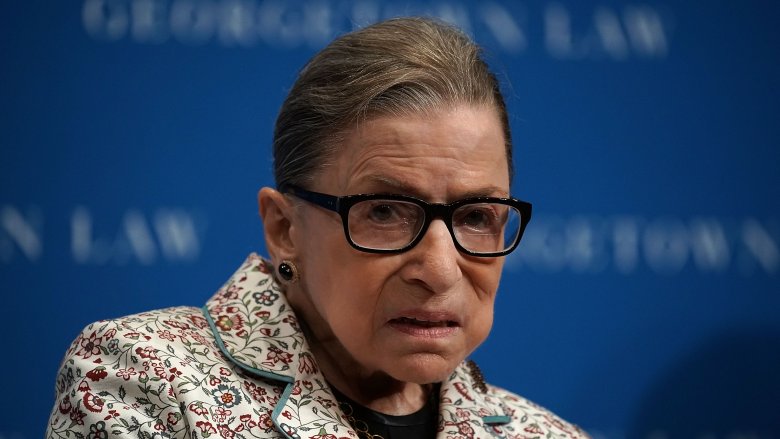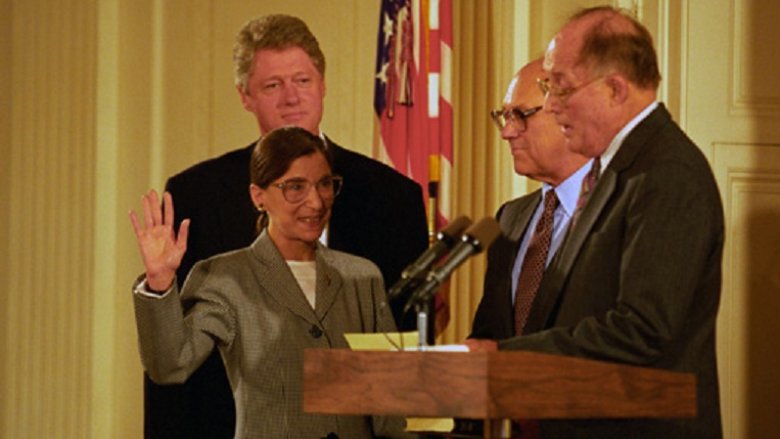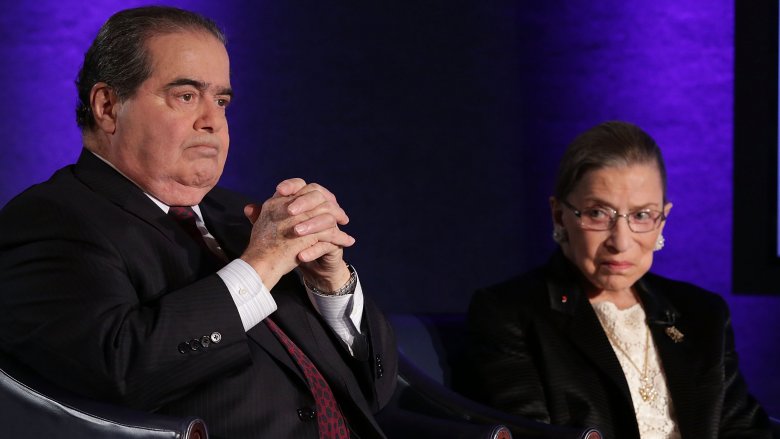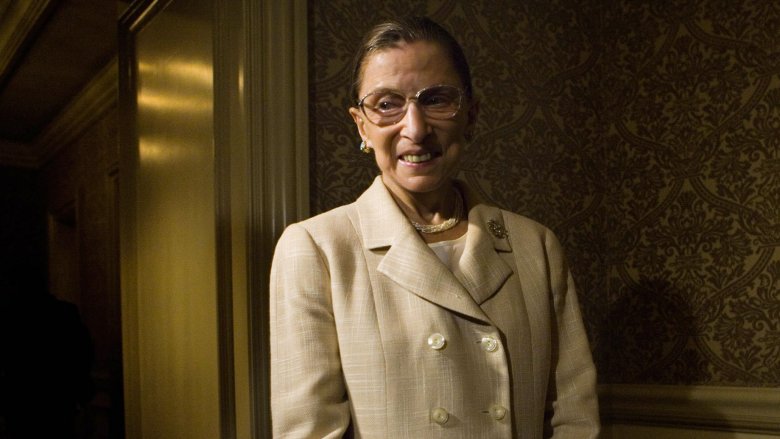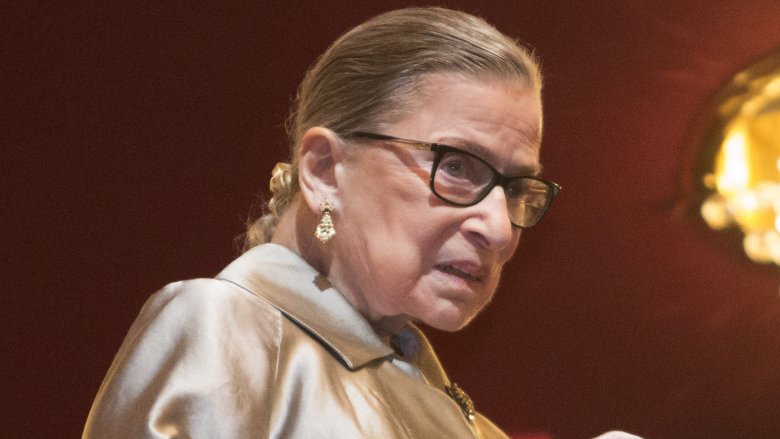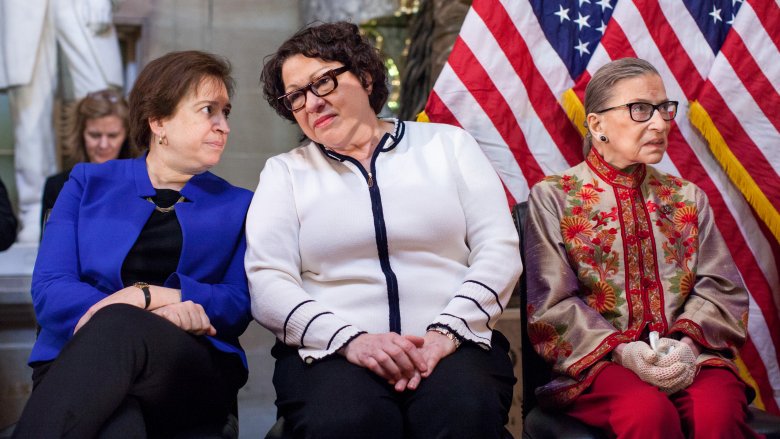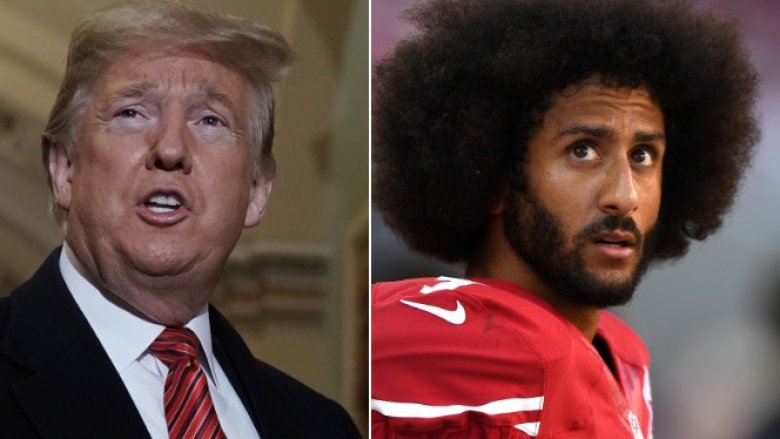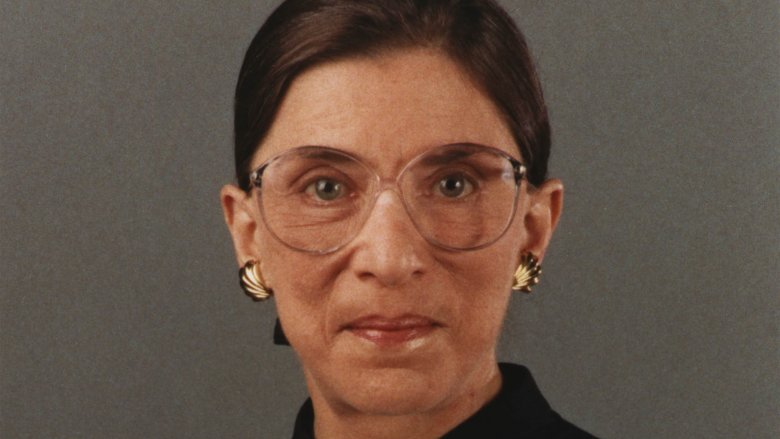The Untold Truth Of Ruth Bader Ginsburg
Compared to the other two branches of government, America's judiciary is pretty darn boring. While the legislative and executive branches are bathed in soap opera drama and the smoky aroma of pants-on-fire lying, federal judges parse nuanced arguments and write meticulously worded opinions. From time to time judges are embroiled in scandals and absurdity, but for the most part they preside over a snooze fest, which might explain why they wear glorified nightgowns to work. However, every so often someone emerges from the sleepy blandness of the bench and captures the imagination and adoration of the (partisan) masses. One of those special few was Supreme Court Justice Ruth Bader Ginsburg.
Affectionately referred to as the "Notorious RBG," Ginsburg rocketed to pop culture prominence in 2013 after a series of fiery Supreme Court dissents inspired an NYU law student to associate Ginsburg with rapper Biggie Smalls (aka "The Notorious B.I.G."). RBG was the second-ever female Supreme Court justice and a forerunner in the fight for gender equality. Equal parts meme and role model, RBG was the subject of a biopic, appeared in toy form in The Lego Movie 2, and inspired an entire music album. Her life was rife with triumphs, tragedies, and fascinating facts.
Ruth Bader Ginsburg died on September 18, 2020, according to a statement from the Supreme Court. She fought cancer on five separate occasions.
The author of 'Lolita' helped her hone her writing skills
According to the American Bar Association, the average U.S. Supreme Court opinion contains 4,751 words. Each of those words serves a purpose, whether it's helping to establish facts of a case, identifying legal questions, or laying out the rationale and ramifications of the ruling. Those words have power to change laws and lives, so every sentence must be carefully crafted. Luckily for RBG, one of her college professors was a phenomenal wordsmith.
Per NBC, while studying at Cornell as an undergrad, Ginsburg took a European literature class taught by Vladimir Nabokov, who famously authored Lolita. In case you haven't read it, Lolita is the fictional first-person account of a child molester who abuses his stepdaughter after his wife dies. The Independent called it "one of the great works of art" of the 20th century, and honestly, if you can get past the feeling of your soul vomiting, it's really an engrossing read (emphasis on "gross").
Anyone who can make the unspeakable enjoyable to read must be a gifted writer. Ginsburg said of Nabokov, "Choosing the right word, and the right word order, he illustrated, could make an enormous difference in conveying an image or an idea." As a justice Ginsburg also attempted "to paint pictures" when writing opinions.
Her objection to Roe v. Wade
Supreme Court decisions are kind of like those math problems in school where the teacher requires you to show your work. Teachers don't just do that to torment you. They do it to torment you and make sure you arrive at your answer the right way. If you just guess the solution or use the wrong reasoning and get away with it, then the next time you face a similar problem you might get the wrong answer because you never really understood what you were doing. Similarly, RBG firmly believes that women should have a right to an abortion but thinks Roe v. Wade was the wrong way to achieve that because of its implications for future abortion cases.
For context, in Roe v. Wade the Supreme Court ruled that women could have abortions for any reason in the first trimester of pregnancy based on their constitutionally protected right to privacy. However, the laws are different in the remaining two trimesters. For Ginsburg, that legal reasoning doesn't quite add up. As a constitutional law professor explained, RBG believes that "for women to attain true equality with men, they must have sole control over their fertility." By that reasoning, tying women's autonomy to a conditional right to privacy established conditional equality and allowed for future restrictions such as the 2007 SCOTUS ruling that upheld a federal ban on late-term abortions.
Her only Supreme Court loss as a lawyer
You don't have to be lawyer to sit on the Supreme Court, per NPR, but every SCOTUS justice has at least studied or practiced law. A few of those lawyers have hit some historic home runs in the courtroom. Before becoming the first black Supreme Court justice, Thurgood Marshall won a slew of civil rights cases and masterminded the legal strategy behind Brown v. Board of Education, which found that racial segregation in schools was unconstitutional. Similarly, Ginsburg won a series of gender equality cases, including Frontiero v. Richardson, which made it illegal to restrict benefits for military spouses on the basis of sex. But not even Babe Ruth batted 1,000, so RBG was bound to lose sometime.
That time came in 1974 in the case of Kahn v. Shevin, Ginsburg's only Supreme Court loss, according to the Conversation. Plaintiff Mel Kahn was a widower seeking a tax exemption that Florida law only afforded to widows. Ginsburg argued that the law was unjust because she saw "discrimination against men and women as equally reprehensible." The Supreme Court disagreed in a 6-3 ruling which said that "single women face significantly more hardship in the job market than single men, and the disparity is particularly true for surviving spouses." Ironically, that disparity stemmed from the same sort of unequal treatment that Ginsburg was fighting against in Kahn's case.
She delivered an opinion the day after her husband died
What do love and justice have in common? They're both blind. So it's only fitting that when Martin "Marty" Ginsburg laid eyes on future justice Ruth Bader it wasn't love at first sight. But it also wasn't long before she had his heart pounding like a gavel. As Marty wrote in a 2010 letter to Ruth, "You are the only person I have loved in my life. ... I have admired and loved you almost since the day we first met at Cornell some 56 years ago." RBG "might have taken a little longer" to fall in love, according to her son James, but once her and Marty's hearts aligned, they had the kind of love some people only dream of.
Married in 1954, Marty and Ruth completed each other. He was an excellent chef. She was a dreadful cook. She was a shy introvert and he was a clever extrovert. When they attended law school and Marty contracted testicular cancer, Ruth shouldered the load of caring for their daughter, Jane, and arranged for Marty's friends to take notes for him. They later won cases together as lawyers, and Marty vigorously lobbied for Ruth to be nominated for the Supreme Court. Sadly, he passed away from cancer in 2010. The next day, RBG delivered the Supreme Court's majority opinion on a case, believing that "Marty would have wanted it this way."
She graduated high school the day after her mother died
RBG is thought of as a feminist icon, but really she could be a hero to anyone who values perseverance, sacrifice, and the pursuit of justice in general. Ginsburg learned those values from her own personal hero: her mother, Celia Bader. A garment factory worker during the Great Depression, Bader gave up her own chance to attend college in order to fund her brother's education, according to Oyez. A woman with a passion for knowledge, she imbued young Ruth with a deep enthusiasm for learning. Per the Jewish Women's Archive, some of RBG's first childhood memories are of going to the library with her mother.
Sadly, their time together was short. Celia Bader contracted cancer and died the day before her daughter's high school graduation. Looking back on their time together, Ginsburg described her mother as "the bravest and strongest person I have known, who was taken from me much too soon." She went on to say, "I pray that I may be all that she would have been had she lived in an age when women could aspire and achieve and daughters are cherished as much as sons." Celia Bader never saw her daughter blossom into an history-making lawyer, but she was with Ginsburg in other ways. When arguing cases before the Supreme Court she wore her mother's pin and earrings.
Her refreshing friendship with Justice Antonin Scalia
Political discourse in the U.S. is what the Jerry Springer Show would be if you added more screaming and made it less classy. So you might expect Supreme Court justices on opposite ends of the political spectrum to at least throw books at each other on occasion. Yet the very liberal Ginsburg and the starkly conservative Antonin Scalia were besties on the bench.
Ginsburg and Scalia became acquainted through academic circles in the 1970s, per CNN, and they first worked together in 1982 as members of the D.C. Circuit of the U.S. Court of Appeals. 1993 marked the start of their lengthy tenure together on the Supreme Court. The pair shared a love of opera and enjoyed each other's company so much that they traveled abroad and liked to dine together on New Year's Eve. Obviously, they clashed on legal matters, but their gavel battles didn't get malicious. In fact, RBG and Scalia learned from other, fine-tuning their own arguments in response to the other's objections.
When Scalia passed away in 2016, Ginsburg summed up their friendship in a touching tribute: "Toward the end of the opera Scalia/Ginsburg, tenor Scalia and soprano Ginsburg sing a duet: 'We are different, we are one,' different in our interpretation of written texts, one in our reverence for the Constitution and the institution we serve. From our years together at the D.C. Circuit, we were best buddies."
How Judaism influenced her career
Fans of the First Amendment know that the U.S. Constitution bars the government from establishing or prohibiting a religion. However, a judge's religious background can shape their overall concept of fairness in positive ways. For Ruth Bader Ginsburg this is true in at least two crucial respects.
Growing up in a Jewish family in Brooklyn, Ginsburg witnessed anti-Semitism firsthand. Her first brush with prejudice occurred while riding in a car with her parents. Ginsburg recalled seeing a sign outside an inn that read "No dogs or Jews allowed." Colleges had quotas for how many Jewish students they admitted, so RBG knew she had to be better than great to secure one of those limited openings. But earning a spot didn't mean getting respect. As freshmen she and the other Jewish women were relegated to a single area of their dormitory. At an award ceremony for Ginsburg, Israeli Supreme Court President Esther Hayut summed up the significance of such experiences: "Law is about justice, and the experience of injustice gives one profound insight as to what justice should look like."
Though Ginsburg wasn't a practicing Jew, she was proud of her heritage and guided by the Jewish principle tikkun olam, or "healing the world." It was a value her mother instilled in her and which defined her life's work.
The truth about the Ginsburg rule
With the sole exception of Abe Fortas, who resigned to avoid impeachment, every judge appointed to the Supreme Court has held their position until death or voluntary retirement. That kind of job security is hard to come by, so naturally nominees try to avoid controversy at all costs during confirmation hearings. However, the two last additions to the SCOTUS during her term, Neil Gorsuch and Brett Kavanaugh, were mired in controversy. (Gorsuch only got nominated when he did because Republicans blocked an Obama nominee for nearly a year, and Kavanaugh was accused of sexual assault.) One of the less salient but nonetheless important sources of disagreement was their reliance on the so-called "Ginsburg Rule" when responding to Senate questions.
Per NPR, the Ginsburg Rule is the term Republicans use to describe the policy of refusing to answer certain kinds of questions. During Ginsburg's confirmation hearings she declined to answer questions about how she might rule in specific future cases. However, she may have been the most responsive SCOTUS nominee ever, and she thoroughly answered questions about her interpretation of the Constitution, or "judicial philosophy." Republicans later expanded the scope of acceptable refusals to cover broader interpretations of the law. In other words, instead of just declining to say how they would rule on specific cases, Gorsuch and Kavanaugh received leeway to dodge questions about how they saw issues like abortion rights as defined in Roe v. Wade, widely regarded as a "litmus test" for justices.
What linguists learned from studying her arguments
In the RBG biopic, On the Basis of Sex, Ginsburg is played by Felicity Jones, who sounded as much like the Brooklyn-born justice as Steve Urkel sounds like Barry White. That's not a knock on Jones' performance — Ginsburg had a distinctive voice and manner of speaking that are hard to replicate. Besides, if you listen to recordings of her Supreme Court proceedings over time, you might notice that the real RBG didn't always sound like herself.
Linguists at NYU made that observation in a study that examined differences in Ginsburg's speech patterns over time. As Time detailed, the researchers looked at how she pronounced vowels and consonants while working as a lawyer in the 1970s and compared that to how she spoke after becoming a judge. A clear pattern emerged: Ginsburg appeared to suppress her accent and natural verbal mannerisms more as a lawyer than as a judge.
Linguists attribute that shift to a phenomenon known as "accommodation," whereby a person adjusts their speaking style to conform to their audience. As researcher Nathan LaFave explained, "She was a female Jewish lawyer presenting before a Supreme Court that was made up mostly of white Protestants, at a time when feminists were being decried as strident and shrill-sounding." Once Ginsburg ascended to a position of power and security, she presumably felt more at ease with being herself on the bench.
She was an accidental activist
Ruth Bader Ginsburg literally wrote the book on sex discrimination and the law. Well, technically she co-wrote it, and according to law professor Wendy Williams, it was the first casebook to cover the topic. Between 1970 and 1980, RBG was involved in roughly 60 gender equality cases, including more than 24 that went before the Supreme Court. She worked so tirelessly that she was said not to have slept for a decade, and she had such an enormous impact that she was dubbed "the Thurgood Marshall of the women's movement." In retrospect it seems like destiny, but when RBG first pursued a legal career, she had no intention of fighting for gender equality, let alone becoming a trailblazer.
Ginsburg recalled enrolling in law school "for personal, selfish reasons. I thought I could do a lawyer's job better than any other. I have no talent in the arts, but I do write fairly well and analyze problems clearly." But simply pursuing law made her a rarity. She was one of just nine women to attend Harvard Law School in 1956, and her professor let her know she wasn't welcome. RBG turned out to be a phenomenal student at Harvard and Columbia Law, which she later attended. She was also a top-notch intern. But she received worse pay and worse treatment than her male colleagues in the workforce and decided to be a vehicle for change.
She insulted Donald Trump and Colin Kaepernick
It's no secret that presidents pick Supreme Court justices for political reasons, but those same judges are expected not to express their views on picking presidents. However, in July 2016, Ginsburg bucked tradition and told the New York Times, "I can't imagine what the country would be — with Donald Trump as our president." Speaking with CNN, she called Trump "a faker," adding, "He has no consistency about him. He says whatever comes into his head at the moment. He really has an ego." The Washington Post, New York Times, CNN, and various Republican politicians called her remarks inappropriate, and Trump called her "a disgrace to the court" and suggested she resign. Ginsburg apologized for commenting on a political campaign.
In October 2016, Ginsburg came under fire again after denouncing NFL players for kneeling during the national anthem to protest racial discrimination and police brutality. RBG acknowledged their constitutional right to protest but called it "dumb and disrespectful" and "a terrible thing to do." Colin Kaepernick, who spearheaded the movement, called her criticism "disappointing" and implied that she was blind to injustices affecting the black community. The creators of the Notorious RBG Tumblr also objected to her statements during a Katie Couric interview. Upon further reflection Ginsburg overruled herself: "Barely aware of the incident or its purpose, my comments were inappropriately dismissive and harsh. I should have declined to respond."
She survived three kinds of cancer
In January 2019, Fox and Friends apologized to viewers after flashing a graphic that wrongly implied Ruth Bader Ginsburg passed away. Maybe someone at the station expected the nearly 86-year-old justice to keel over after undergoing surgery to remove cancerous lung growths in December 2018. If so, that person should have known better because RBG had already kicked cancer's keister two other times.
Ginsburg's first oncological battle happened back in 1999, six years after being appointed to the Supreme Court. The Washington Post reported that doctors first misdiagnosed her illness as acute diverticulitis. Thankfully someone realized she had colon cancer before it progressed too far. In 2009, Ginsburg was afflicted with pancreatic cancer. As with her other two struggles, RBG was the best and worst kind of lucky. She was the best kind of lucky in that her tumor was detected about as early as technologically possible, per ABC. She was the worst kind of lucky in that once again she had to survive cancer. In November 2018, her lung cancer was discovered after she fell and fractured multiple ribs. RBG was one tough cookie.
